Earliest trails ever made by an animal discovered by scientists
Origin of symmetric animals with segmented bodies 550m years ago is monumental event that led to evolution of humans

The earliest trails ever made by an animal have been discovered in China.
The fossilised remains and prints of Yilingia spiciformis – which translates as spiky Yiling bug - a primitive animal that walked the Earth more than half a billion years ago, were found in multiple layers of rock near the eastern city of Yiling.
It dates back to the Ediacaran period between 635 to 541 million years ago.
The fossils were found near other bug-like footprints discovered in 2018 that also date back to the Ediacaran period, although the body of that animal was not preserved.
The origin of the newly discovered symmetric animals with segmented bodies (known as bilaterians) is a monumental event in early animal evolution that led to the evolution of humans and most animals.
Before these two discoveries, it was long believed that they appeared during the Cambrian explosion about 541 to 510 million years ago when many animal groups first appeared in the fossil record.
However, these fossils prove that they appeared much earlier, according to a paper about them published in Nature.
“This discovery shows that segmented and mobile animals evolved by 550 million years ago. Mobility made it possible for animals to make an unmistakable footprint on Earth, both literally and metaphorically,” said lead researcher Shuhai Xiao, a professor of geosciences with the Virginia Tech College of Science.
The animal that made the latest prints would have looked like a millipede and was around a quarter of an inch wide and four inches long. It would have dragged its body across a muddy ocean floor and rested along the way, leaving a trail that is 23 inches long.
It would have been made up of 50 or more body segments, a back and belly, and head and tail, researchers say.
The find also marks what could be the first example of decision-making among animals. The trail suggests an effort to move towards or away from something, which indicates the animal could have had a sophisticated central nervous system.
“Animals and particularly humans are movers and shakers on Earth. Their ability to shape the face of the planet is ultimately tied to the origin of animal motility,” said Professor Xiao. “We are the most impactful animal on Earth. We make a huge footprint, not only from locomotion, but in many other and more impactful activities related to our ability to move.
“When and how animal locomotion evolved defines an important geological and evolutionary context of anthropogenic impact on the surface of the Earth.”

Rachel Wood, a professor in the School of GeoSciences at the University of Edinburgh, who was not involved with the study, said: “This is a remarkable finding of highly significant fossils. We now have evidence that segmented animals were present and had gained an ability to move across the seafloor before the Cambrian, and more notably we can tie the actual trace-maker to the trace.
“Such preservation is unusual and provides considerable insight into a major step in the evolution of animals.”
Join our commenting forum
Join thought-provoking conversations, follow other Independent readers and see their replies
Comments
Bookmark popover
Removed from bookmarks